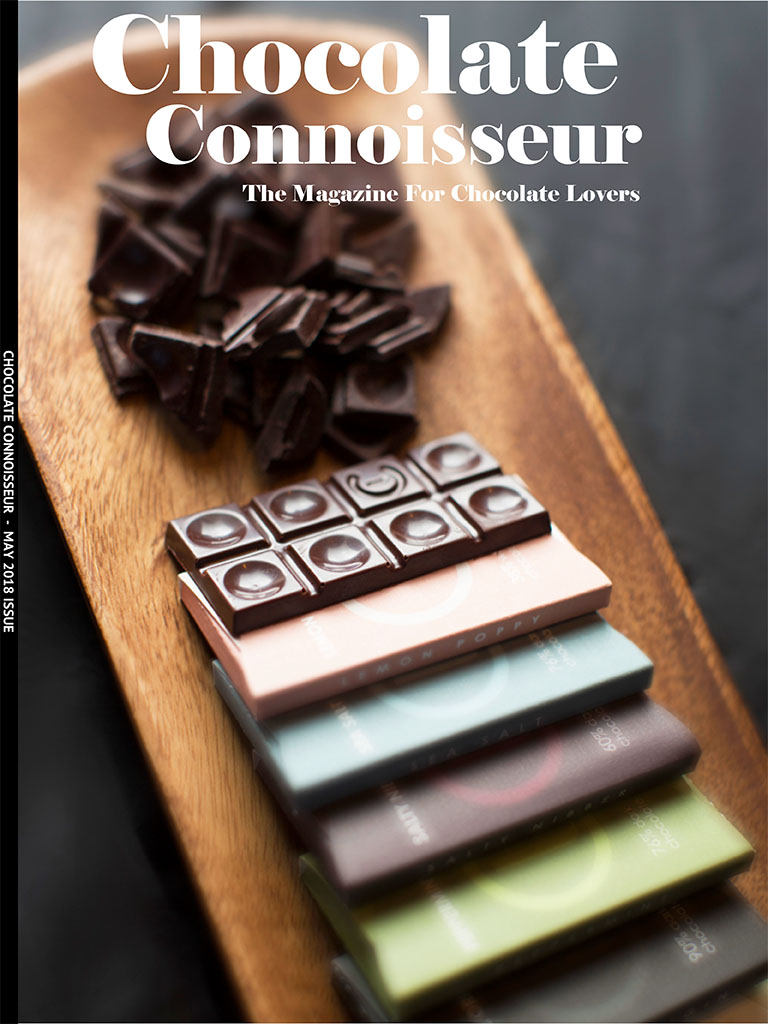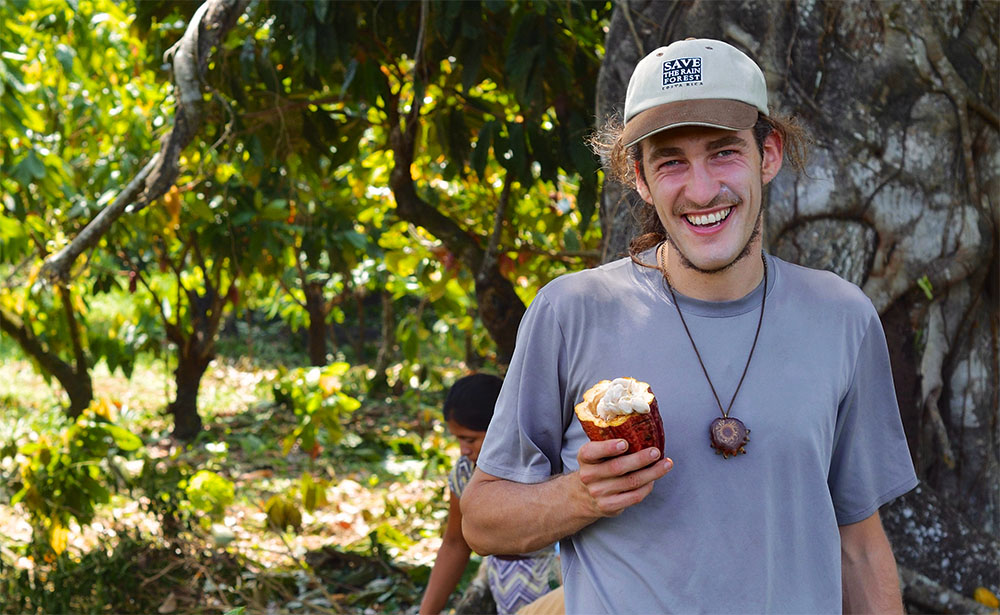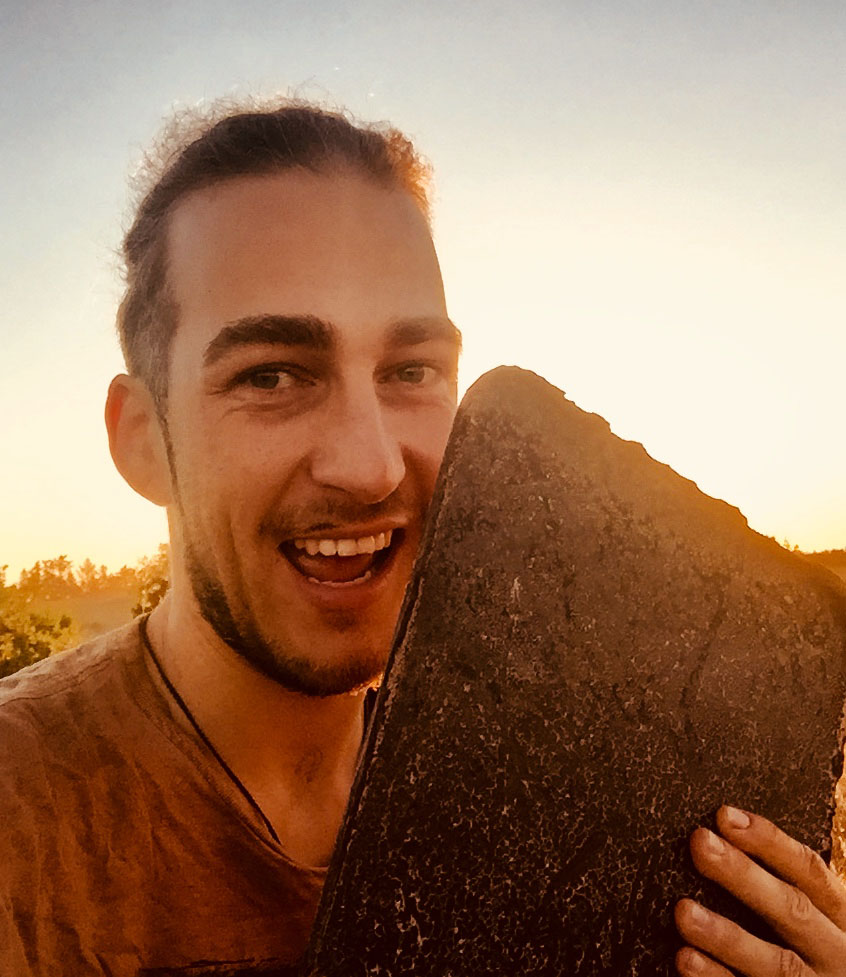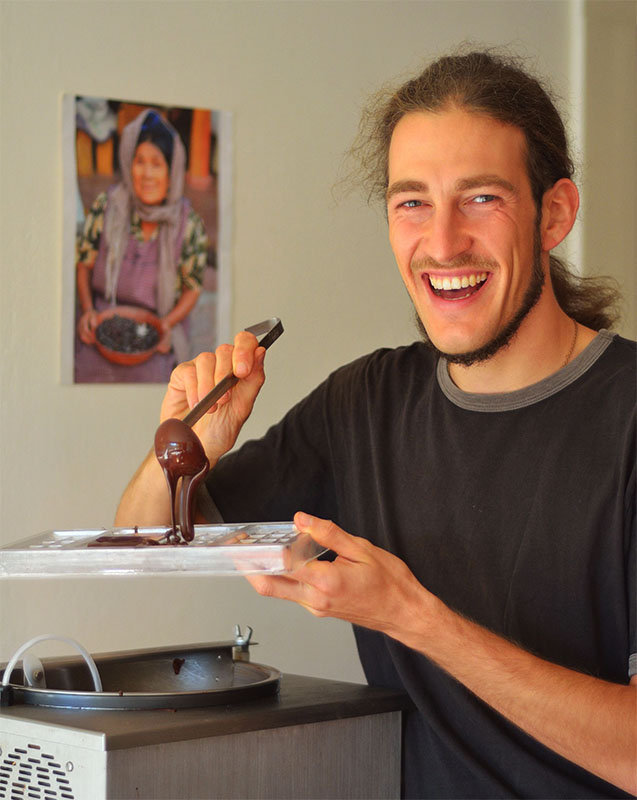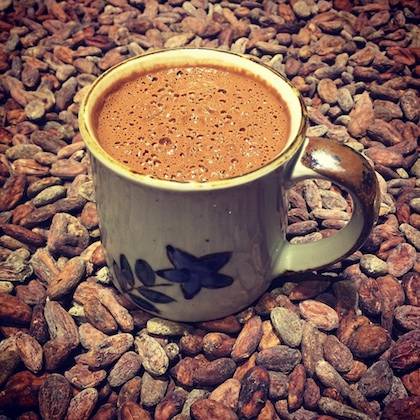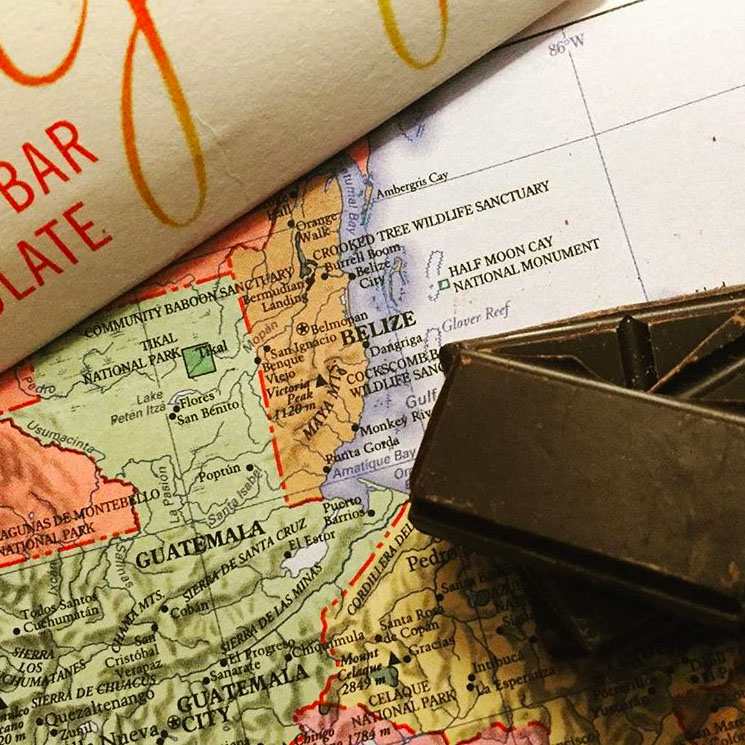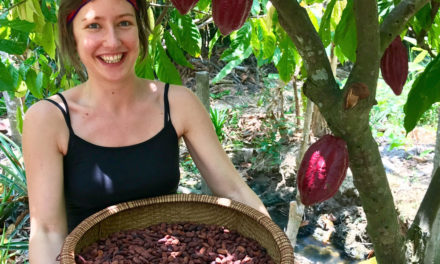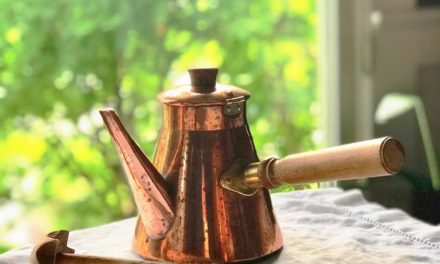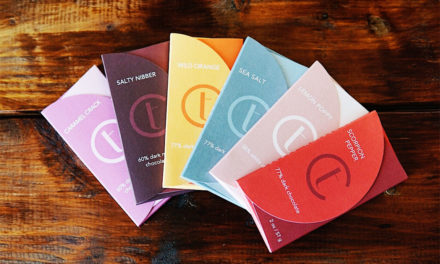Firefly Chocolate
Fireflies are Free to Fly
If you’ve ever met Jonas Ketterle of Firefly Chocolate and Ceremonial Cacao, I know you will agree he flashes one of the most joyful smiles in the chocolate-making world. I first experienced Firefly Chocolate at the Northwest Chocolate Festival in 2016, initially drawn in by their unique Bay Nut chocolate bar, a seasonal variety. The bar features bay nuts from the California Bay Laurel Tree (related to the avocado family) in Umbellularia, which Jonas wild harvests around October and November.
Firefly also lists the exact percentages of each key ingredient on every label – ingredients such as cacao, inclusions, and coconut sugar, another attractive feature of their unique chocolate line. Then, of course, there’s Firefly’s drinking cacao. Jonas practices daily use of Ceremonial Cacao, both on his own and with groups.
You can view Firefly’s full line of Ceremonial Cacao on their website at the links at the end of this article. My personal favorite? The 100% Boundless Belize. First, however, read on to discover Jonas’ chocolate journey from mechanical engineering to chocolate making and Ceremonial Cacao practices…
Jonas Ketterle (JK): When I first left school I joined Fenix International, a company founded by a classmate of mine. Our focus was working on affordable distributed solar in developing economies. Yet after a few years, I felt the demanding hours and constant “on” of a tech startup were too much. I finally gave notice and flew to Oaxaca, Mexico with my girlfriend. That was May 2012. There we discovered open fire-roasted, hand-peeled and stone ground chocolate making through an amazing Zapotec indigenous elder as our guide.
We were high on chocolate for the rest of our trip, and when I came back to the states, I used all my new found free time to read online about chocolate making and made my first batches. My next pivotal moment was two years later, when I decided to stop eating any and all sugar to address chronic headaches I was experiencing. Combined with a regular yoga practice to de-stress my lifestyle, this actually did have a significant impact on reducing my headaches.
But I knew I wouldn’t be able to stay away from chocolate for long… that’s when I began using coconut sugar (a low glycemic index sweetener) and reduced sugar content by half in my bars, down to 15%. Interestingly, that’s when friends became really interested in my chocolate, and I realized there was a market opportunity for truly healthy chocolate. So I began Firefly Chocolate in 2014 and by the end of the year moved into a commercial space to produce chocolate.
JK: No not currently – I save them all for chocolate because it’s my favorite! After my return from Oaxaca, I enrolled in a nine month long permaculture and nature awareness immersion on the Marin coast. That’s where I learned about bay nuts, acorns, and many other wild foods growing all around us. And I learned that harvesting and wild-tending these foods requires intimate knowledge of the ecosystem.
My relationship to local lands started with bay nuts, but quickly became so much deeper. Since I depended on the ecosystem for a part of my food source, I became curious about it, I spent more time in it, and I cared about it. I began experiencing a far deeper connection with, and a belonging to, the California I had lived in for ten years already.
So this is why I began to share wild harvest bay nuts in a chocolate bar… as a way of sharing this experience of belonging to our California Coast ecosystem. The indigenous peoples of the coast used, and still use, bay nuts, acorns, and more as traditional foods. I think we have much to learn from them… how to live as stewards of our local ecosystem… and I know that if we do, crises such as the fires in Sonoma county six months ago can be averted by better land management practices.
Chocolate Transparency
VC: You’ve been very specific in listing exact percentages for each of the ingredients in your chocolate bars. Why do you find that to be so important?
JK: I believe that with food, total transparency is important. Everyone deserves to know exactly what they’re eating so they can make a conscious choice about it. With chocolate labels, it has long bothered me that the general public was completely unaware that a 70% dark chocolate bar has twice as much sugar as an 85% dark chocolate bar. Understandably so, because the difference in cacao percentage is small.
But this is the kind of misleading labeling that really bothers me … what should be labeled is that one bar has 30% sugar while the other one only has 15%. You could eat two 85% bars before you have the same sugar intake as one 70% bar! So that’s an enormous difference in sugar consumption and resulting impact on healthy lifestyle, and consumers shouldn’t have to figure all that out on their own. It’s an honest company’s responsibility to be transparent with their products.
JK: My most impactful travels to source cacao have been in southern Belize. When I visit I stay for longer than most chocolate makers, and I embed in the operations of the Maya Mountain Cacao co-operative.
I’ve participated in cacao buying trips, home-stays with indigenous farming families, third party social impact audits, micro-finance loan administration trips, cooperative-wide farmer meetings about pricing, and of course, plenty of time wandering agroforestry cacao farms, geeking out on cacao fermentation, and tasting fresh cacao off the tree.
Simple labels like “Organic” or “Fair Trade” really don’t do any justice to the depth of involvement and long term commitment required for working with communities that depend on cacao for a livelihood. Medicinally cacao is a major food group in people’s diet … it is drank morning and night daily, and I can see it in how vibrantly healthy the families are.
It’s critically important to preserve and support traditional ecological knowledge about how cacao grows within a rainforest ecosystem … the web of life there involves hundreds of edible and medicinal species, and cacao is a keystone species for supporting communities in right relationship with rainforest stewardship. I’m looking to further travels for cacao sourcing this year … visits to Guatemala and Tanzania are on my calendar 🙂
JK: My practice of using ceremonial drinking chocolate began with a chocolate bar I no longer produce, called “Spicy Chai”. It was a blend of my Belizean Cacao, coconut sugar, cinnamon, cardamom, ginger, and cayenne. I would just take pieces from a chocolate bar, and melt that. I’m remembering a pivotal moment when I was on a back packing trip in Kauai, and the cacao guided me to drinking a very large dose of cacao.
Up until this point, for about a whole year, I had been having only very small portions of cacao daily and carefully cataloging its effect on my state of mind and physical body. It honestly hadn’t occurred to me that I could have a larger dose – I think a part of me still believed that chocolate is bad for you from the two decades of my life when I had known chocolate only as candy.
Days that I drink cacao are consistently better than days that I don’t drink it, so, I basically drink it every day now. A simple cacao ritual begins with gratitude, and setting of intention or asking for guidance on questions I am holding. Then I drink the cacao, and pay attention. The key I recommend is to stay open – every experience with cacao is different, and it is easy to expect or attach to a certain experience. Our internal landscape is constantly changing, and as a result the way the cacao works with us is different too.
This is true relationship, rather than consumption – we never know what we are showing up to, and that is a part of the gift. Cacao can have immediate physical affects, and the experience can peak several hours in and last 6-8 hours or beyond. It can both be subtle or very apparent. Ultimately, we all need help opening our hearts.
This modern world we live in gives us so many reasons to shut down or hide from the many hurts, injustice, and violation of life. Cacao makes us stronger and connects us to our inner warrior / warrioress… by nurturing our hearts, tending to them, we can stay connected and open. This is where our joy lies, our compassion, our creativity, our ability to come together in community and create a better world.
Ceremonial Cacao
VC: What have you found to be most interesting about the history of cacao being used ceremonially, and cacao being used medicinally? What is important to know about the history of cacao ceremonies?
JK: It is hard to know what the true form of ancient cacao rituals were, largely because of the epidemic loss of shamanic wisdom on healing plants when over 95% of the indigenous American population was wiped out due to disease and warfare (when the conquistadors came in the 1400s). Cacao traditions I’ve observed at origin are likely only a few hundreds of years old, at best. I tell people not to get too hung up on how it used to be done. All of the ancient traditions emerged in the cultural context of those times, and originally came through the plant.
VC: What if a person lives in a crowded area and/or doesn’t have easy access to a relaxed outdoor setting, or maybe even their indoor area is shared/noisy? Any suggestions on still getting some benefits?
JK: Cacao is a powerful adaptogen – it will have medicinal benefits regardless of the setting in which it is consumed. I do recommend a quiet setting to get to know it and observe its effects without interruption. But these days I’ll frequently drink cacao and find myself in urban settings – which can be a lot of fun, say on a dance floor or at a party.
Half the cacao drink after all is water … and it’s important to stay well hydrated before, during, and after cacao ceremony as it can be mildly dehydrating.
VC: Do you still host the monthly cacao ceremonial men’s circle? If so, will you talk more about that and what benefits it brings?
JK: I co-facilitate two monthly men’s circles with cacao – one on the new moon and one on the full moon. It’s one of my monthly highlights, because my peers come together to co-create and experience the kind of compassionate, vulnerable, grounded masculinity so needed in the world right now and so absent in many of our political and cultural leaders.
It’s critically important for men to gather right now and de-construct the patriarchy, so that we can be allies in the movement for gender equity and reconciliation. I see this transformational work having deep impact on love relationships as well as deepening friendships amidst men who so often lack intimate connection and true sharing with each other. As a result of this work, I’ve never felt so strong a feeling of tribe and resourcefulness with having so many authentic male friendships in my life.
JK: Mushrooms are incredibly good for us. I highly recommend Paul Stammet’s work for anyone who is curious. The mushrooms in our drinking chocolate have immune boosting and neuro-regenerative functions, and are said to boost longevity. Each mushroom species targets our body in a unique way, so that is why we use a blend of fourteen different ones. They all have different flavors as well, so the complex blend lends a very umami like experience to the drinking chocolate that actually reduces it’s natural bitterness without any added sugar.
Ten different chocolate offers shipped to you throughout the year, plus a free Annual Subscription to Chocolate Connoisseur Magazine. A Chocolate Connoisseur Premier Membership is like no other…
JK: I’m a purist in my drinking chocolate… I simply take our 100% cacao discs, pour hot water on them, and agitate the mixture for 15 seconds so the drink is thick and frothy. As a chocolate maker I like to taste the flavors uniquely present in each cacao, and am always paying attention to flavor notes I like and how I can bring them forth more. Of course a lot of fun can be had with recipes, using different teas and nut milks, or spices and other superfoods. But my personal practice is very basic in this regard.
VC: At the end of the day what is your intention when it comes to making and sharing ceremonial cacao and Firefly chocolate bars?
JK: My intention for sharing ceremonial cacao is to connect people to cacao as a healing plant. We don’t commonly conceive of it as such because most of us have grown up with an industry that gives us chocolate as candy. But having experienced and witnessed its healing and transformative impacts again and again, I’m convinced this is the future of our society’s relationship to chocolate.
I’m also deeply invested in this vision because we cannot continue to destroy tropical rainforest ecosystems and violate and exploit indigenous communities in the way that we have been. I believe relating with cacao consciously rather than consuming it as candy will drive increasing awareness and resources towards establishing reciprocal relationships, long term stewardship, and restoration of our planet’s valuable gifts.
VC: Thank you for this interview Jonas!
Website: https://ceremonial-cacao.com/
Instagram: https://www.instagram.com/cacaoceremony/
NOTE: All photos by Firefly Chocolate unless otherwise noted.

